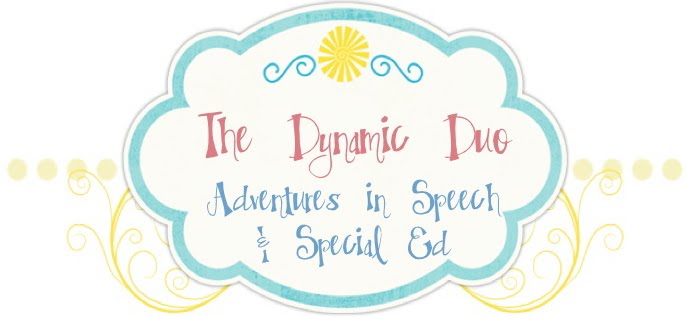I'm sure I'm not the only one who has had the experience of working with a small group (or even an individual student!) and struggling to keep a lesson from being hijacked by near constant blurting, wiggling, and off topic commentary. Sometimes getting through a thirty minute lesson can be as exhausting as a full workout! Too bad it doesn't burn as many calories...
The concept that saves my sanity on many-a-day is Whole Body Listening. No, this is not a new concept, but it is definitely one of the most valuable in my toolbox. This concept was originally published in Language, Speech, and Hearing Services in Schools by Susanne P. Truesdale. I use WBL in different ways depending on the age, maturity, and location of the student.
In my classroom, I have a visual on the wall to remind students of what is expected when in group.
Sadly, I have no clue whom to credit for this visual. My cooperating teacher shared it with me when I was a student teacher. If you have knowledge of the original source, please tell me in the comments!
My Teaching Assistant and I use the same visual (copied, reduced, and laminated) on our lanyards to cue students within the inclusion classroom to use Whole Body Listening in all school settings.
Another super cute Whole Body Listening visual for younger students is offered free by first grade teacher, Erica Bohrer from http://www.ericabohrer.blogspot.com. Check her out!
I also regularly use what we call Whole Body Listening Helpers in Social Thinking groups and academic resource groups. This idea was originally based on a technique described in Michelle Garcia Winner's Thinking About You, Thinking About Me. She described using small play-doh balls to represent each group member and "pinching" off a small piece of play-doh when the student's brain or body left the group. I originally tried this, but my students didn't really seem to care whether their play-doh was pinched. I had to up the ante. Hmm....what would they not want to lose? Oh, yeah! Legos! Legos are HIGH value in my world. I tried placing a Lego mini-figure on an index card. The rule was once the mini-figure was on the card then the kids couldn't touch it. As long as they kept their brain and body in the group then the mini-figure stayed. If their brain or body left the group, then I would take the figure off the card. The response was immediate and dramatic! They worked so much harder to stay focused in group and when their Lego guy left the group, they noticed immediately and corrected their behavior. Finally! A visual representation that was meaningful and effective!
We've since branched out for some of the younger students who are more interested in animals. In the 1st/2nd grade Social Thinking group that Orlanda and I co-teach, we started feeling like we were getting whiplash from taking the WBL helpers off and putting them back on over and over again. We brainstormed again and decided to limit the amount of times the kids could lose their helpers and still be able to get a sticker on their chart at the end of group. Knowing how intensely distracted this particular group can be, we decided that they could have three chances per thirty minute group before they lost their opportunity to earn a sticker. We added three boxes to their index cards and put three animal WBL helpers in the boxes. When they lost a helper, it did not return. If they had at least 1 helper left at the end of group, they could put a sticker on their chart. If they managed to keep all three helpers, then they would earn double stickers. Whoa, buddy! That got their attention! Since putting this in place, we've seen a great increase in on-task behavior during group.
Finally, a couple of good books to use when teaching Whole Body Listening.
I love that several primary teachers at my school have invited me in to teach Whole Body Listening to their entire class. It makes me chuckle when I hear the teachers encourage their students to "Be a Larry!"
So, here's to all the Larry's in our lives! Please share with us how you use Whole Body Listening in your classrooms or treatment groups. We want to hear from you!
~Kelley
Truesdale, S. (1990). Whole-Body Listening: Developing Active Auditory Skills. Language, Speech, and Hearning Services in Schools, 21, 183-184.







I just have to add that I use this concept in MOST of my speech therapy groups! The other "helpers" that come in handy are the my collection of Kid's Meal figures. The only "rule" in my speech therapy room is to use Whole Body Listening and lots of my kids start their session by choosing their helper before we even start our activity. --Orlanda
ReplyDeleteIf you google "Whole Body Listening Poster" - Larry's WBL poster will come up!
ReplyDeleteI started using the Whole Body Listening Poster and book with my SDC class this morning and they really got into it. I like using the helpers though. I will try that tomorrow. Most of my boys love legos, so here come the legos!
ReplyDelete